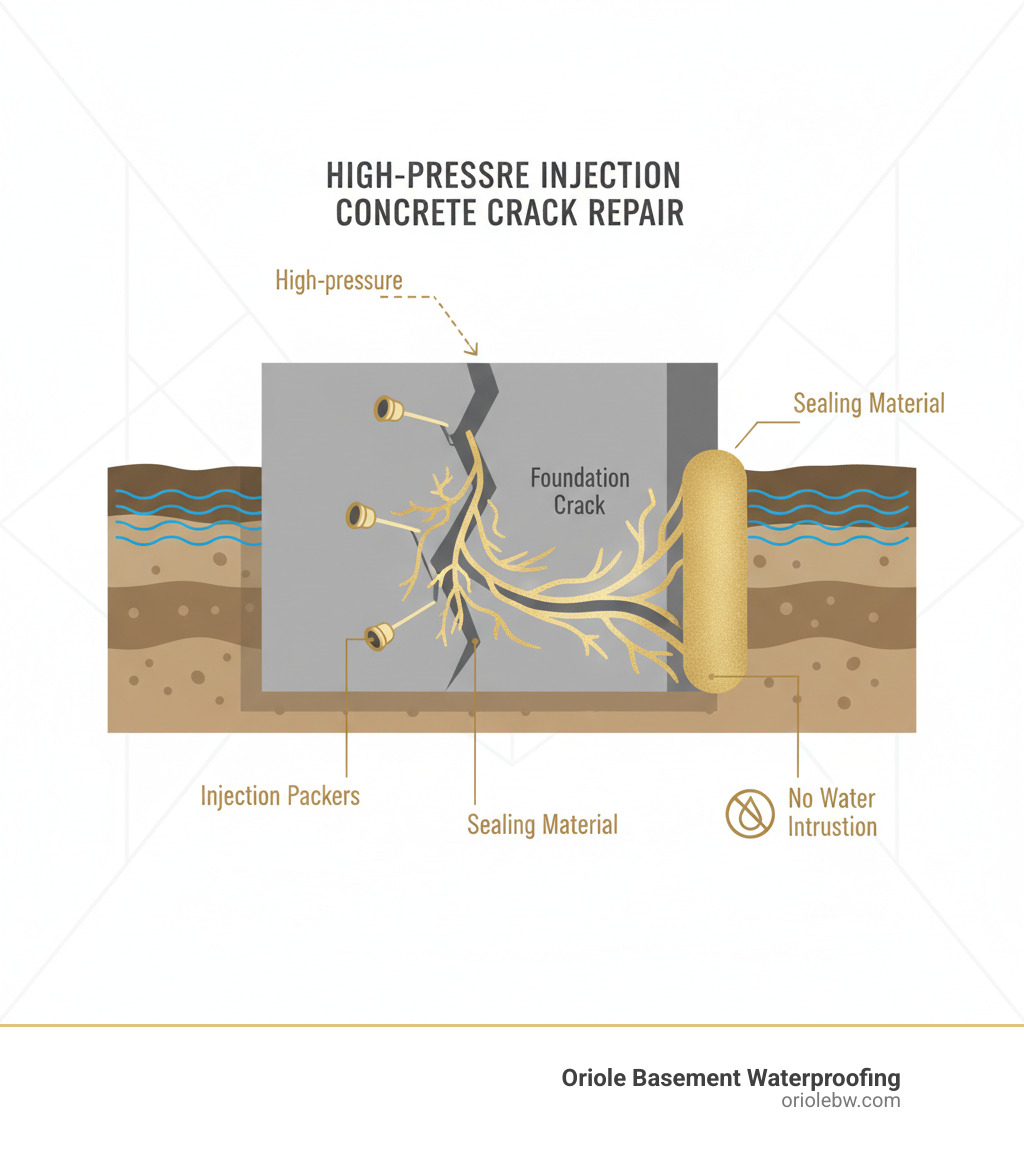Why That Crack in Your Foundation Isn’t Just a Crack
High pressure injection concrete crack repair is the professional method of sealing foundation cracks by injecting specialized materials like polyurethane foam or epoxy resin under controlled pressure directly into the crack structure.
Quick Answer for High Pressure Injection:
- Materials Used: Polyurethane foam (for active leaks) or epoxy resin (for structural repair)
- Pressure Range: 200-1000+ psi depending on crack width and material type
- Best For: Hairline cracks, actively leaking cracks, and vertical foundation cracks
- Process: Drill injection holes → Install packers → Inject material under pressure → Seal and cure
- Professional Required: Yes – improper pressure can cause concrete spalling
That hairline crack in your Baltimore County basement isn’t just a cosmetic issue. With every Maryland freeze-thaw cycle and heavy rain, it can grow, becoming an entry point for water and potential structural problems. What starts as a thin line can turn your basement into an unwelcome indoor pool during the next big storm.
The good news? Modern high pressure injection can create a permanent seal that’s often stronger than the concrete itself. However, a lasting repair depends on using the right material and correct pressure. Too little pressure means an incomplete seal, while too much can damage your foundation, creating a bigger problem. This is where professional expertise is crucial.

The Professional’s Guide to High Pressure Injection Concrete Crack Repair
When you’re dealing with foundation cracks in your Baltimore home, high pressure injection concrete crack repair is a precise science. It requires understanding your specific crack, choosing the right material, and applying it with the expertise that comes from our seven decades of Maryland basement repairs. Each crack tells a story, and we know how to listen.
Choosing the Right Material: Polyurethane vs. Epoxy
The difference between a repair that lasts decades and one that fails often comes down to one decision: choosing the right material. At Oriole Basement Waterproofing, we’ve seen what happens when the wrong choice is made.
When We Reach for Polyurethane Foam
If you’re watching water seep through a crack after a heavy rain, polyurethane foam is our weapon of choice. This material is hydro-active, meaning it reacts with water to expand up to 30 times its original size. When injected under high pressure (often over 1,000 psi), it fills the entire crack and creates a flexible, waterproof seal that moves with your foundation during Maryland’s seasonal shifts, preventing future leaks.
When Epoxy Resin Takes the Lead
For cracks that aren’t leaking but compromise your foundation’s strength, we use epoxy resin. Think of it as a high-strength glue that welds the concrete back together, making the repaired area stronger than the original wall. Because it creates a rigid bond, our professional assessment is key to ensure the foundation has stopped moving. Applying epoxy to a moving crack will only lead to it cracking again.
Here’s how these materials stack up for high pressure injection concrete crack repair:
| Feature | Polyurethane Foam | Epoxy Resin |
|---|---|---|
| Best for | Active leaks, flexible sealing | Structural repair, dormant cracks |
| Pressure needed | High (1000+ psi, up to 2000 psi) | Moderate (few hundred psi) |
| Flexibility | High – moves with concrete | Low – rigid bond |
| Water reaction | Expands 15-30x when wet | Stable, non-reactive |
| Crack width | Hairline to wider cracks | 0.002 inches and wider |
The key is matching the material to your specific situation in Baltimore City, Baltimore County, or Harford County. For more insights, check out our guide on Cracked Basement Maryland: Causes and Solutions.
The High-Pressure Injection Process: What to Expect
When our team arrives for high pressure injection concrete crack repair, you’re getting a systematic process we’ve refined over 70+ years.
- Assessment: Our technicians first analyze the crack’s width, depth, and activity. This determines the material choice and injection pressure.
- Surface Prep: We clean the area around the crack to ensure a proper bond, sometimes wire brushing or V-grooving the crack to reach sound concrete.
- Packer Placement: We drill small holes at strategic intervals and install injection packers. These ports create a secure seal for injecting material under high pressure.
- High-Pressure Injection: Using specialized equipment, we inject the chosen material. We monitor pressure carefully (sometimes over 1,000 psi) to achieve full penetration without causing spalling. We continue until the crack is completely full.
- Finishing: After the material cures, we remove the packers and patch the holes, leaving a clean, strong repair.
This process is part of our comprehensive approach. For more information, explore our Basement Wall Leak Repair services.
Why Professional High Pressure Injection Concrete Crack Repair is Crucial
While DIY kits exist, high pressure injection concrete crack repair is a job for professionals. Here’s why attempting it yourself can lead to disaster:
- Safety Risks: We work with pressures over 1,000 psi and chemical resins that require professional-grade protective equipment and ventilation to manage hazards like silica dust. For more on this, learn about silica dust safety from the experts.
- The Concrete Spalling Nightmare: Too much pressure can blow a chunk out of your foundation, turning a small crack into a major, expensive repair. Our technicians have the experience to apply the exact pressure needed.
- Ensuring a Complete Seal: A DIY repair often fails to penetrate the full depth of the crack. We inject until we achieve “refusal,” meaning the crack is filled from the inside wall to the exterior soil. This is why we can offer a lifetime guarantee.
- Diagnosing the Root Cause: A crack is a symptom. Our experts diagnose the underlying issue to provide a permanent solution, not a temporary band-aid. This approach is what separates a lasting repair from a temporary fix. See how this fits into our overall strategy in our overview of 5 Foundation Repair Methods.
Ensuring a Lasting Repair for Your Maryland Home
After your high pressure injection concrete crack repair is complete, you want to know it’s fixed for good. In Baltimore City, Baltimore County, and Harford County, we know Maryland weather is relentless, so our repairs have to be bulletproof.
Verifying the Repair and Long-Term Durability
How do you know the repair worked? The simplest proof is a dry basement, even after a heavy Maryland storm. That’s our primary measure of success.
The long-term durability comes from using the right material. Flexible polyurethane moves with your foundation, preventing re-cracking from seasonal shifts. Rigid epoxy bonds the concrete, making the repaired section stronger than the surrounding wall. Our confidence in these methods is why we offer a lifetime transferable guarantee. But we don’t just fix the crack; we investigate the root cause, from grading to drainage, to ensure it’s a permanent solution. A lasting fix requires understanding the whole picture, which you can learn more about here: Why is Basement Waterproofing Necessary? The Risks of Skipping It.
When is High Pressure Injection Concrete Crack Repair the Best Solution?
High pressure injection is the gold standard in specific situations. After 70+ years, we know it’s the best solution for:
- Poured Concrete Walls: Common in local homes, their uniform structure is ideal for injection.
- Leaking Cracks: Polyurethane’s water-reactive properties make it perfect for stopping active water intrusion.
- Hairline Cracks: High pressure is the only way to force material into these tiny fissures and prevent them from growing.
- Vertical Cracks: Often caused by settlement or concrete shrinkage, these are prime candidates for a permanent seal.
- Fixing Failed Repairs: We can inject material behind old, failed patches to create the seal that should have been there all along.
Of course, our initial assessment is key. If we find a crack is due to major structural movement, we’ll recommend a more comprehensive solution. We always match the right repair to the specific problem. Learn about all your options in our guide to Basement Leak Repair Solutions to Protect Your Home.
Secure Your Foundation with Expert Help
Your foundation supports your entire home; it deserves expert care, not guesswork. When you choose Oriole Basement Waterproofing for your high pressure injection concrete crack repair, you’re getting 70+ years of Maryland-specific experience and a lifetime transferable guarantee.
Our certified technicians don’t just fill a crack; we diagnose why it formed and implement a permanent solution. That crack in your basement won’t fix itself. Let’s turn that problem into a permanent solution, backed by our lifetime guarantee.
Ready to get it fixed the right way? Learn more about our expert Foundation Repair services and schedule your free inspection today.







